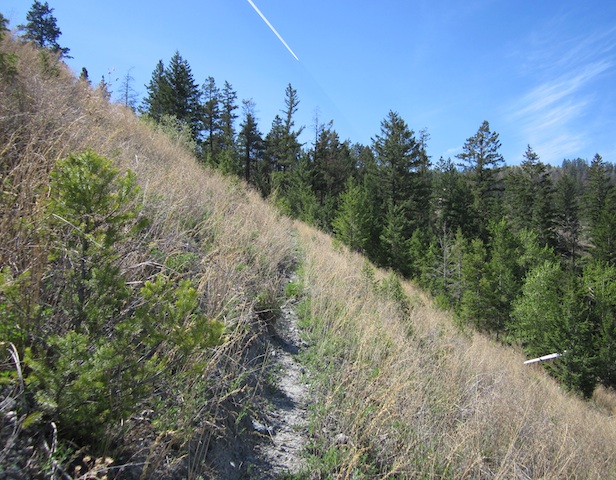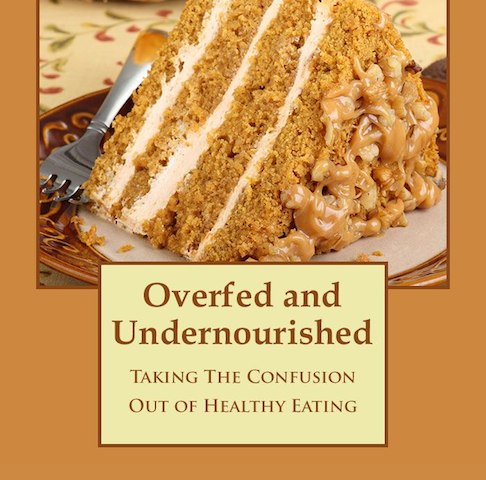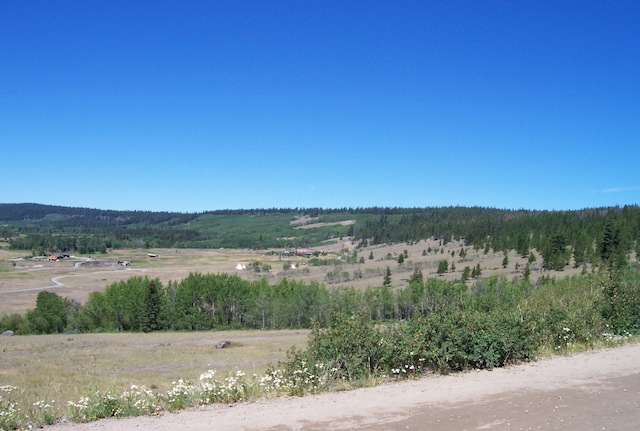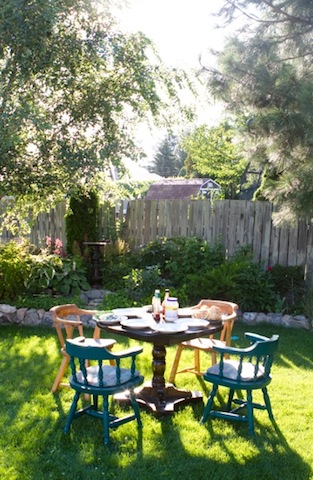
This is the lower part of the hill looking west. It is very dry and the soil is poor. You can see the narrow path the goes to the top of the hill. We are dumping waste organic materials in the area below the path to help hold water.? Cobbles fall onto the path making walking dangerous.
Last winter we put away meat, vegetables, fruit and dairy in freezers. For more information please read Winter Storage Part I and Part II. We lived off our cold stores and dried goods until the middle of March this year before having to go to the grocery store for fresh vegetables and fruits. Living off winter stores was a very educational experience for my family. We had some problems with our root cellar freezing at one point during the winter. We lost some carrots, potatoes and parsnips due to freezing. We lost a few squash to rot, but for the most part, everything made it through the winter in very good condition.
The one thing I would change for next year would be to grow greens under indoor lights. I would like to grow Chinese greens, parsley, cilantro and try to over winter some tomatoes and peppers. For the hens, growing flats of spelt grass is a wonderful winter supplement. I would like to have a lemon, lime and avocado tree. I don’t think this is very practical, but I’m thinking about it.
This spring we are ready to increase the challenge. We have decided to try producing as much food as we can on our property. On the back of our property we have about an acre of unused land. Unfortunately, the area has a steep slope and faces north. There is a gully on the west side filled with small fir and alder trees. The rest of the hill has tiny fir trees trying to get a start on the steep, rocky slope. The parent material is clay and cobble. There is a small skidder trail at the top of the property which could become a garden after we build some soil with chickens.
Shaen has started to terrace the slope. There are a few weeks every year after the snow melts when the soil is not hard as rock. In a few weeks this window will close and the soil will refuse the pick. He has started a main path to the upper area at about a 25 degree angle. He needs the path to be large enough to get a wheel barrel up the hill to where we will have chickens in a hoop house on deep litter. This deep litter will take up the nitrogen from the chicken droppings. After the chickens are finished, we will grow heavy-feeding, heat-loving plants such as squash, peppers and tomatoes in the hoop house.
After Shaen finishes the main path to the upper area, he plans to run smaller horizontal paths off the main path. We will be planting the slope using permaculture principles. We will be using a drip system for watering to get the plants going. We are trying to decide what type of plants we want on the slope. Blueberries, currents, hazelnuts, black walnut, fruit trees, and other edible perennials will make up the base planting. We will plant Russian olives, honey locust, and other plants for wild animal, bird and insect consumption. We want a place for the wild in our garden.

This is about half way up the hill looking west. As we move closer to the gully and the trees there is more ground cover.
We have also leased four acres from a local farmer, which we are hoping to develop into pasture for cows, pigs and chickens. The four acres are covered with mature pine and alder trees. There is native sage, sedges and forbs. The area is covered with bunch grass. The land has well water at the top of the property that we can gravity feed to the area we want to convert to pasture. We have done a lot of reading about pasture development and management. We would like to put some of that theory into practice, if we can.
We will have access to the leased property later in the summer. We will move Patty, our Jersey cow, to the new property after we have built a hay shed and shelter for her. We have plans to try out Joel Salatin’s intensive pasturing system using electric fencing and controlled grazing. We can run the hens or broilers after the cow to eat the maggots out of the cow’s patties and spread the patties, fertilizing and improving the pasture. This sanitizes the pasture for the cow’s later return. We have dreams of hogs digging up the gully and doing the heavy work of turning compost for us.
I will continue to update through the summer about the progress of these two research projects.

This is the top of the hill looking east. There is a flat area and small road to my right. The treed area is right behind me.
Updated May 13, 2012: Please read Brittle Grassland Pasture Undated: Photo Essay. We decided to shelf terracing the slope while we focus on the pasture project.







